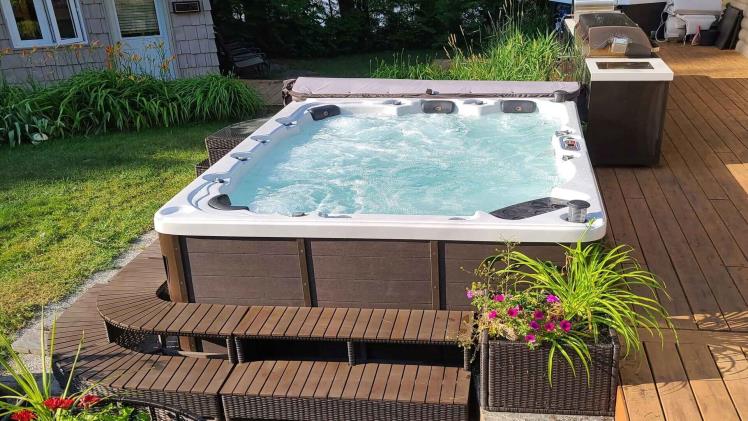Hot tubs are a luxurious addition to any home, offering relaxation, stress relief, and therapeutic benefits. However, along with the enjoyment they provide, hot tubs also come with electrical requirements that must be carefully considered for safety. One common question that arises when installing a hot tub is whether the wiring needs to be enclosed in a conduit. In this blog post, we’ll delve into the importance of hot tub wiring and whether conduit is necessary for its installation.
Understanding Hot Tub Wiring
Before discussing the necessity of conduit for hot tub wiring, it’s essential to understand the basics of hot tub electrical systems. Hot tubs require a dedicated electrical circuit to power the pumps, heaters, lights, and other components. This circuit typically consists of a ground fault circuit interrupter (GFCI) breaker to protect against electrical shock and ensure safety.
The wiring for a hot tub must meet specific requirements outlined by electrical codes and regulations. These requirements are in place to prevent electrical hazards and ensure the safe operation of the hot tub. Improper wiring can lead to electrocution, fire hazards, and damage to the hot tub itself.
The Role of Conduit in Electrical Wiring
A conduit is a protective tube or channel used to enclose electrical wires. It serves several purposes in electrical installations, including:
- Protection: Conduit shields wires from physical damage, such as impact or abrasion, which can occur during installation or over time.
- Containment: Conduit keeps wires organized and contained, reducing the risk of tangling or entanglement.
- Environmental Protection: In outdoor or exposed installations, conduit protects against moisture, sunlight, and other environmental factors that can degrade wiring.
Now, let’s explore whether hot tub wiring needs to be enclosed in conduit.
Do You Need Conduit for Hot Tub Wiring?
The answer to whether conduit is necessary for hot tub wiring depends on several factors, including the local electrical codes, the type of installation, and personal preference. Let’s break it down:
- Local Electrical Codes: Electrical codes and regulations vary by region, and it’s essential to consult the codes applicable to your area before installing a hot tub. Some jurisdictions may require conduits for all electrical wiring, while others may have specific requirements for hot tub installations. Always adhere to the local codes to ensure compliance and safety.
- Type of Installation: The type of installation plays a significant role in determining whether conduit is necessary for hot tub wiring. In-ground hot tubs, for example, may require conduit to protect the wiring from damage caused by excavation, landscaping equipment, or other outdoor elements. Above-ground hot tubs installed on a concrete pad or deck may have different requirements, depending on the proximity to water and exposure to the elements.
- Personal Preference: Even if local codes do not require conduit, some homeowners may choose to install it for added protection and peace of mind. Conduit can provide extra safety and durability, especially in harsh environments or high-traffic areas.
Benefits of Conduit for Hot Tub Wiring
While conduit may not always be mandatory for hot tub wiring, there are several benefits to consider:
- Enhanced Protection: Conduit offers superior protection against physical damage, moisture, and environmental factors, prolonging the wiring’s lifespan and reducing the risk of electrical hazards.
- Easy Access for Maintenance: With conduit, the wiring is easily accessible for maintenance and repairs, allowing electricians to troubleshoot and service the hot tub more efficiently.
- Neat and Professional Appearance: Conduit provides a clean and professional-looking installation, concealing the wires and enhancing the hot tub area’s aesthetic appeal.
- Compliance with Future Regulations: Even if the conduit is not required at the time of installation, it may become necessary in the future if electrical codes are updated or revised. Installing conduit now can ensure compliance with future regulations without the need for additional modifications.
Considerations for Conduit Installation
When deciding whether to install conduit for hot tub wiring, consider the following factors:
- Material: Conduit is available in different materials, including PVC, metal, and flexible conduit. Choose a material suitable for the installation environment that meets local code requirements.
- Size: Select the conduit size based on the number and size of wires and any additional components, such as conduit fittings or bends.
- Installation Method: Depending on the installation requirements and preferences, the conduit can be installed either surface-mounted or buried underground.
- Professional Installation: For complex installations or if you’re unsure about local code requirements, consult a qualified electrician to ensure proper conduit installation and compliance with safety standards.
Conclusion
In conclusion, while hot tub wiring may not always need to be enclosed in conduit, it’s essential to consider the local electrical codes, the type of installation, and personal preferences when determining the best approach. Conduit offers added protection, accessibility, and aesthetic benefits, making it a worthwhile investment for many hot tub installations. Whether you choose to install conduit or not, prioritize safety and compliance to ensure a safe and enjoyable hot tub experience for years to come.

